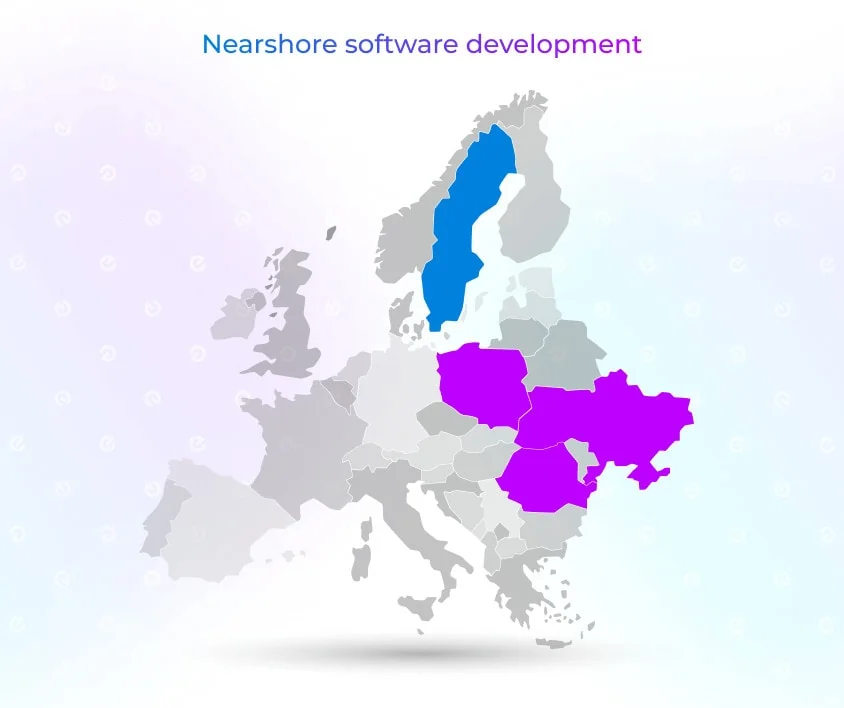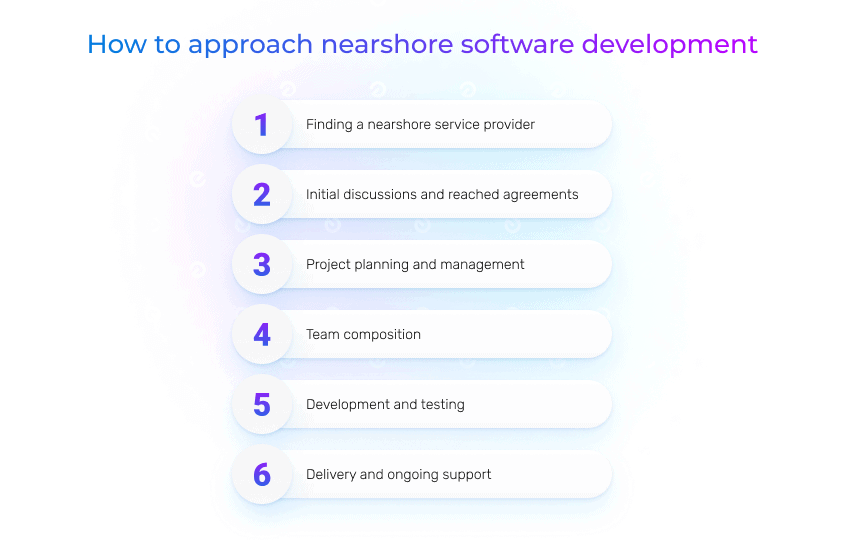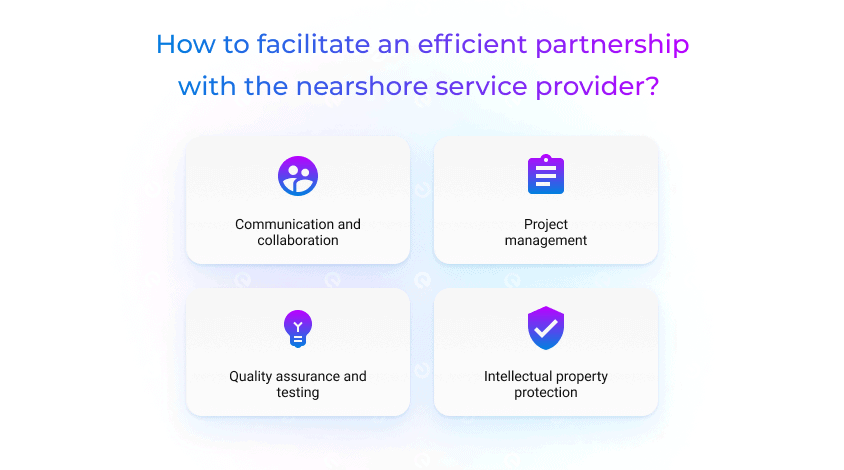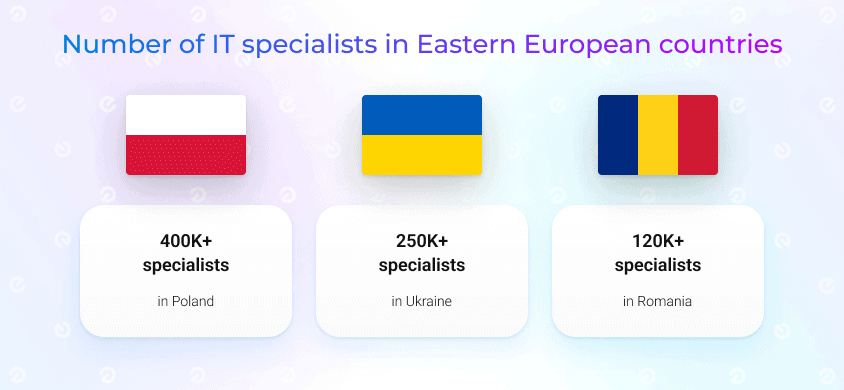
Updated: July 4, 2024
Published: April 4, 2023
Would you like to access a wider pool of developers and greater expertise for software development? Nearshore software development can become a good option for consideration. Check the article to find more details on how to approach this outsourcing model and how to turn it to your business advantage.
List of the Content
- What is nearshore software development?
- How does nearshore outsourcing work?
- Advantages of nearshore development services
- Best practices for nearshore software development
- Poland, Ukraine, and Romania as popular nearshore outsourcing locations for Western Europe
- Nearshore software development cost
- Conclusion
WHAT IS NEARSHORE SOFTWARE DEVELOPMENT
Nearshore software development is a popular outsourcing strategy involving hiring a software development team in a nearby country or region. This type of outsourcing is popular among companies looking to reduce costs while maintaining a similar time zone and cultural similarities to their home country. To effectively leverage nearshore software development, it’s essential to understand its key characteristics.
One of the main aspects of this outsourcing model is proximity. The development team is located nearby, making it easier to travel and collaborate face-to-face. This proximity also allows for more effective communication and collaboration through video conferencing, phone calls, and email.
Another characteristic of nearshore development is cultural similarities. The development team is typically located in a country with a similar culture to the hiring company, making it easier to understand and work with one another. This cultural similarity also reduces the risk of misunderstandings and miscommunications.
Lastly, nearshore software development services typically offers cost savings compared to onshore development while still maintaining effective communication and collaboration. These cost savings are due to lower labor costs in the nearshore country while still providing quality work.
If we compare it with other outsourcing models, offshore software development involves outsourcing software development to a team located in a distant country, usually with a significant time zone difference. This approach can offer cost savings, but it often requires significant communication and collaboration challenges due to time zone differences and cultural differences. On the other hand, onshore software development involves working with a team in the same country as the hiring company. This approach can offer more effective communication and collaboration but can also be more expensive.
Looking for more details about offshore software development?
We recommend reading this article about this outsourcing approach and its specifications.
Nearshore software development combines the benefits of both offshore and onshore development. Companies can enjoy cost savings while maintaining a close working relationship with the development team due to the similar time zones and cultural similarities.
It effectively allows companies to outsource their software development needs while maintaining effective communication and collaboration. Companies considering nearshore software development should carefully evaluate potential partners and ensure they have the necessary experience, expertise, and cultural compatibility to achieve their development goals.
HOW DOES NEARSHORE SOFTWARE DEVELOPMENT WORK?
For a better understanding of nearshore development, it’s important to consider how this engagement model works and what key stages it covers.
- Finding a nearshore software development company
The first step is finding a suitable company to work with. Companies can do this by searching online or by attending industry events where they can meet potential partners. It is important to evaluate the company’s reputation, experience, and expertise before making a decision.
- Initial discussions and agreements
Once a nearshore software development company is selected, the next step is to hold initial discussions to establish project goals, requirements, and timelines. This stage also involves signing a contract and agreeing on project deliverables, scope, and pricing. The contract should also include provisions for handling potential issues such as project delays, scope changes, etc.
- Project planning and management
The nearshore software development company will create a project plan that outlines the project’s objectives, the resources required, and the schedule. The project manager will oversee the plan’s implementation, ensuring that the team adheres to the project’s scope, budget, and timeline. They should also establish clear communication channels and protocols to ensure the client is regularly updated on the project’s progress.
- Team formation and development
The nearshore software development company will assemble a team of skilled developers, QA specialists, and designers to work on the project. The team will have the necessary skills and experience to develop software that meets the client’s requirements. The nearshore software development companies will also ensure that the team is familiar with the client’s business processes and culture to ensure seamless collaboration.
How to set up an effective cross-functional team?
You can read more about the team composition and efficient approaches for collaboration here.
- Development and testing
The development team will start working on the software according to the project plan. They often use agile methodologies to ensure that the software is developed incrementally and that it meets the client’s requirements. The testing team will verify that the software meets the agreed-upon requirements and that it is free of errors and bugs. This stage may involve multiple iterations of development and testing to ensure that the software meets the client’s expectations.
- Delivery and ongoing support
After the software is developed and tested, the nearshore development team will deliver it to the client. The client will then provide feedback, and the development team will make any necessary changes or modifications. The nearshore outsourcing companies will continue to provide ongoing support and maintenance as needed. This stage is critical to ensuring that the software remains functional and up-to-date over time.
Overall, nearshore software development works by leveraging the skills and expertise of a remote team to develop software that meets the client’s requirements. The process involves finding a suitable partner, establishing clear goals and expectations, and managing the project effectively to ensure that it is completed on time and within budget. Effective communication and collaboration are key to ensuring a successful outcome.
ADVANTAGES OF NEARSHORE SOFTWARE DEVELOPMENT
Nearshore software development can provide a range of benefits to companies looking to outsource their software development needs. The distinct advantages of nearshore outsourcing include the following:
- Similar time zones: It supports better team collaboration and communication due to overlapping working hours. This can be especially beneficial for agile development methodologies, where frequent communication and collaboration are crucial. Being in a similar time zone can also facilitate faster response times to any issues or questions arising during development.
- Cultural similarities: Countries that are geographically close often have similar cultures, which can help bridge any communication gaps between teams. This can lead to better and stronger team relationships and more effective collaboration. Additionally, cultural similarities can help to ensure that the developed software meets the cultural expectations and requirements of the end users.
- Cost savings: Nearshore software development can be more cost-effective than onshore development while still providing access to a talented pool of developers. The cost savings come from the lower labor costs in the nearshore location while still leveraging the same technical skills and expertise as the onshore location. Additionally, nearshore development can help companies avoid some of the hidden costs associated with offshore outsourcing, such as language and cultural barriers.
- Access to specialized expertise: Nearshore outsourcing can allow companies to tap into the specialized expertise of developers in other countries. For example, if a company needs a team with a particular set of skills like software development for finance, they may find it more cost-effective to look for those skills in a neighboring country rather than hiring a new team onshore. Additionally, nearshore software development can provide access to a wider talent pool with different perspectives and experiences.
- Reduced risks: Working with a nearshore development team can offer some benefits of offshore outsourcing while reducing the risks associated with cultural and language barriers. For example, while offshore outsourcing can provide access to even lower-cost labor, time zone differences, and language barriers can create communication challenges. Nearshore outsourcing allows companies to work with teams in countries with similar cultures and languages while reducing the miscommunication risk and supporting the project’s success.
- Proximity and ease of travel: Nearshore outsourcing offers the advantage of being geographically closer to the client’s location. This makes it easier for both parties to meet face-to-face, facilitating stronger relationships, better collaboration, and more effective communication. Additionally, travel costs are often lower for nearshore development than for offshore development.
By leveraging these benefits, companies can reduce costs, access specialized expertise, and improve the overall success of their software development projects.
Looking for a professional nearshore software development company?
Existek specializes in providing both offshore and nearshore software development services to cover the needs of our customers and build full-fledged solutions from scratch.
BEST PRACTICES FOR NEARSHORE SOFTWARE DEVELOPMENT
Considering this outsourcing model, gathering some advice on ensuring a successful nearshore software development partnership will be useful. As long as the business establishes best practices, it helps to facilitate effective communication, collaboration, and project management. Let’s consider some important aspects related to best practices for nearshore software development. We’ve decided to group them into the following categories.
Communication and collaboration
- Regular communication channels and schedules are important for involved members to stay on the same page. Daily or weekly check-ins can help inform everyone about project progress, issues, and priorities.
- Video conferencing tools can help build personal relationships between onshore and nearshore team members. Seeing each other face-to-face can foster better engagement and trust.
- Open and transparent communication is valuable for building trust and ensuring everyone’s concerns are heard. Encourage feedback, questions, and concerns from both the onshore and nearshore members.
- Clear roles and responsibilities for both the onshore and nearshore teams can help avoid confusion and duplication of effort. Clearly define who is responsible for what, and be definitely aware of their responsibilities.
- Encouraging knowledge-sharing and cross-training can help build a cohesive and versatile team. Consider organizing joint training sessions or assigning team members to work on different project parts to foster learning and growth.
Project management
- Choosing the right project management methodology is key to ensuring the project is completed on time and to the required quality standards. Different projects require different project management methodologies. For example, Agile is well-suited to projects with changing requirements, while Waterfall is better suited to projects with well-defined requirements.
- It’s important to break down the project into manageable tasks and assign them to specific team members. As a result, it can help ensure that progress is being made and that everyone knows what they need to do.
- Project management tools such as JIRA, Redmine, or Asana can help track progress, identify bottlenecks, and mitigate risks. These tools can also help the onshore and nearshore teams collaborate more effectively.
- Conduct retrospectives and learn from both successes and failures. Continuously improving the project management process can help the team become more efficient and effective over time.
Quality assurance and testing
- Ensuring that the software meets quality standards is essential to the project’s success. Defining quality standards and testing criteria upfront ensures everyone achieves the same objectives.
- Establishing a testing plan covering functional, performance, security, and usability testing can help ensure the software meets the required quality standards.
- Automated testing tools and frameworks can help improve efficiency and accuracy. Besides, it could reduce the risk of human errors.
- Conducting both manual and automated testing can help ensure comprehensive software coverage.
- Providing timely feedback and bug reports to the nearshore team can help resolve issues quickly and efficiently.
Intellectual property protection
- Signing an NDA can help protect your intellectual property and confidential information. Ensure that all members of the nearshore team sign an NDA before they start working on the project.
- Use version control software like Git to track changes and protect your code. Consider using encryption or other security measures to protect your code.
- Clearly define the owner of the intellectual property created during the project. Ensure that the ownership rights are stated in the contract.
- Conduct regular audits to ensure the nearshore team adheres to your intellectual property protection policies.
- Ensure that the nearshore team complies with all legal requirements related to intellectual property protection.
Combining the best market practices allows you to build a strong and effective nearshore team to help your organization achieve its software development goals.
POLAND, UKRAINE, AND ROMANIA AS POPULAR NEARSHORE LOCATIONS FOR WESTERN EUROPE
It’s worth saying that this outsourcing model has become increasingly popular over recent years, with many companies outsourcing their software development projects to nearshore locations. If we take a look at Western European companies, they often choose such countries as Poland, Ukraine, and Romania. These outsourcing locations have emerged as popular nearshore destinations due to their highly skilled workforce, competitive costs, and proximity to Western Europe. Let’s discuss why Poland, Ukraine, and Romania have become popular nearshore locations for Western Europe and the advantages of nearshore software development in these countries.
The main benefit of nearshore software development is that companies can save costs while still receiving high-quality services. That is because countries like Poland, Ukraine, and Romania have highly skilled and experienced developers who work for lower wages than their Western European counterparts.
Nearshore software development also offers other benefits, such as cultural similarities, time zone compatibility, and ease of communication. These factors make nearshore outsourcing a popular choice for companies that want to outsource their software development projects but also want to maintain a level of control over the development process.
Eastern European countries are popular nearshore locations for Western Europe due to their highly skilled workforce, competitive costs, and proximity to Western Europe.
- Poland, Ukraine, and Romania have a large pool of talented IT professionals with expertise in various technologies and programming languages. Companies can hire developers with the right skill set for their projects and benefit from their experience and knowledge.
- The cost of living in Eastern Europe is significantly lower than in Western Europe, which translates to lower developer wages. Companies can save costs without compromising on the quality of work.
- They are located close to Western Europe, making communication and collaboration easier. Companies can work with their development teams in real-time to ensure the project is on track.
- All European countries share similar cultural similarities, which makes it easier for companies to work with their development teams. Developers in these countries are familiar with Western European business practices and can adapt to their client’s needs.
- Eastern Europe shares a time zone with many Western European countries, meaning there is a minimal time difference between the two regions. That makes communication and collaboration easier and ensures the project is completed on time.
Poland, Ukraine, and Romania offer several advantages for companies looking to outsource their software development projects, including access to highly skilled developers, lower costs, and ease of communication. Companies can benefit from nearshore software development by partnering with development teams in these countries and ensuring that their projects are completed on time and to their satisfaction.
What are other popular outsourcing destinations?
You can actually read our previous article about other top IT outsourcing countries to learn more about known global locations for outsourcing.
NEARSHORE SOFTWARE DEVELOPMENT COST
Software development rates in nearshore locations are typically lower than in onshore locations. This is because nearshore development teams are often based in countries with lower labor costs and living costs, allowing them to offer more competitive rates while still providing high-quality software development services.
For example, the hourly rate for a software developer in Western Europe can range from $45 to $85 or more, depending on the developer’s experience and expertise, while the hourly rate for a nearshore developer in Poland or Ukraine may range from $30 to $50 per hour. That commonly results in significant cost savings for companies that choose to work with nearshore development teams.
While nearshore development can often be more cost-effective than onshore development, a variety of factors can still influence the overall cost of your project.
It’s worth noting that rates can vary widely depending on the specific location, the skill level of the development team, and the project’s complexity. It’s important to conduct thorough research and due diligence to ensure that you work with a reputable nearshore development company that can provide high-quality software development services at a fair price.
Let’s consider the mentioned factors that impact nearshore software development costs:
- The cost of living and labor rates can vary significantly between countries, even within the same region. For example, the cost of nearshore development in Poland may differ from that in Romania or Ukraine. Understanding the differences in labor rates and cost of living can help you choose the most cost-effective nearshore location for your project.
- The nearshore development team’s experience and skill level can also impact your project’s cost. More experienced developers obviously charge higher rates, but they can also work more efficiently, produce higher-quality code, and deal with more complex tasks.
- Finally, the complexity and scope of your project will also impact the cost of nearshore development. More complex projects may require a larger and more experienced development team, which can drive up costs. Similarly, larger projects with more extensive requirements may take longer to complete, which can also impact the project’s overall cost.
Considering these factors, businesses have better chances to make informed decisions about nearshore development and choose a location and team that meets their budget and project needs.
CONCLUSION
Many companies choose nearshore outsourcing because it offers numerous benefits, such as lower costs, similar time zones, cultural similarities, and easier communication and collaboration due to geographic proximity. It has become a strategic and cost-effective way for businesses to access top talent, expand their capabilities, and increase their competitiveness in the global market.
Have you thought about outsourcing your project development?
At Existek, we provide full-cycle software development services to address our customer needs while delivering the best market products and services.
Frequently asked questions
What is nearshore software development?
Nearshore software development is a model of outsourcing software development services to a company located in a neighboring or nearby country. This approach offers several benefits over traditional offshore outsourcing, such as a closer time zone, cultural similarities, and reduced language barriers.
What are the popular nearshore outsourcing locations for Western European countries?
The popular nearshore outsourcing locations for Western European countries include Poland, Ukraine, and Romania. These countries have emerged as popular destinations for outsourcing software development projects due to their highly skilled workforce, competitive costs, and proximity to Western Europe.
How to develop an efficient partnership with nearshore software development companies?
The good practices of effective outsourcing focus on the following aspects:
- Communication and collaboration
- Project management
- Quality assurance and testing
- Intellectual property protection
What influences nearshore software development costs?
Software development rates are considerably lower in the nearshore locations. However, they also can vary due to the complexity and scope of the project, developers’ expertise, cost of living, engagement model, etc.





